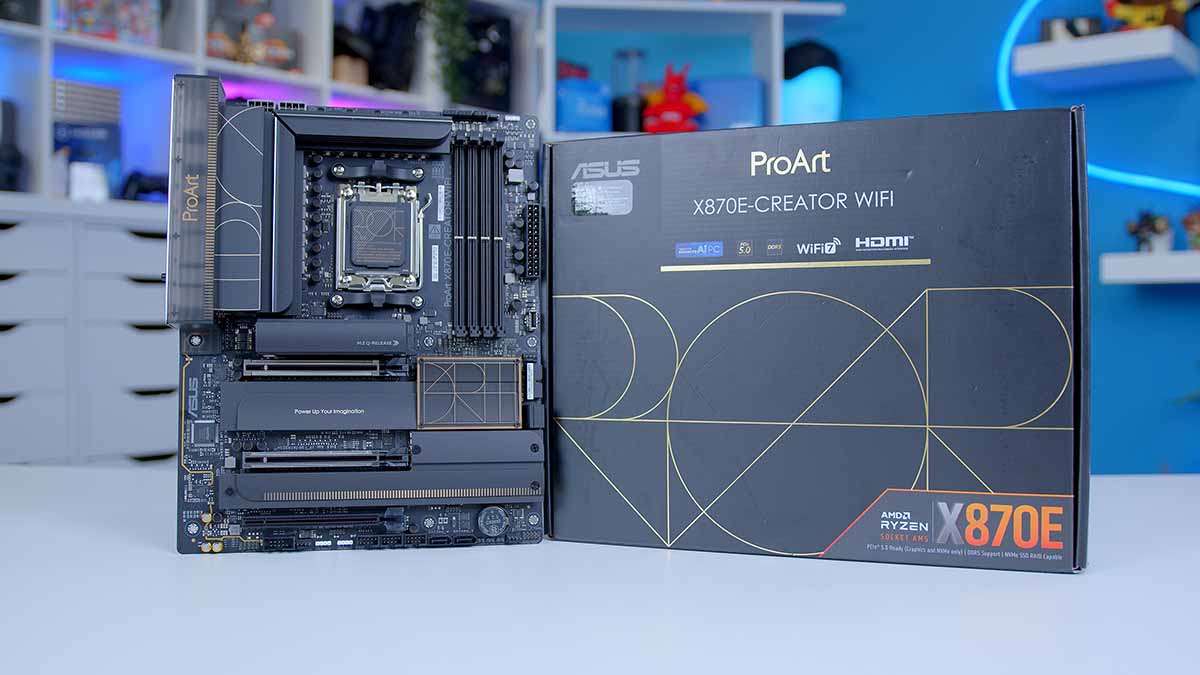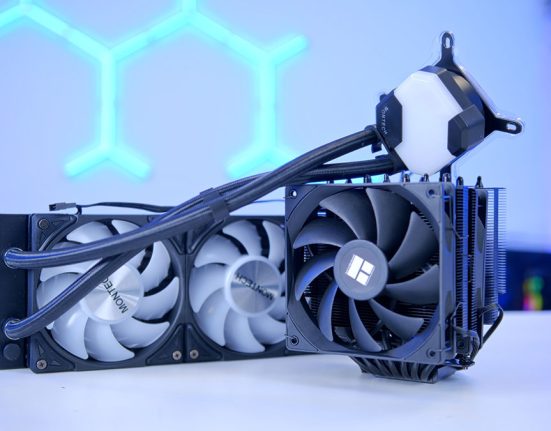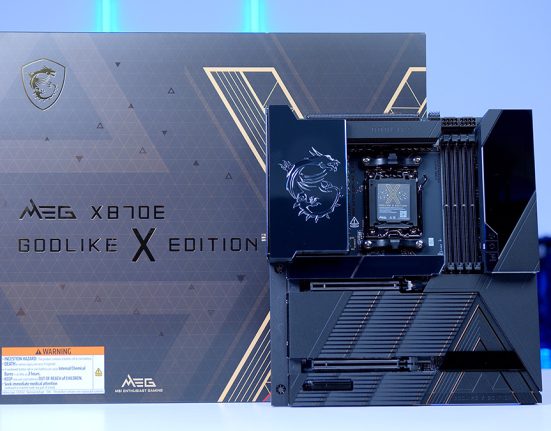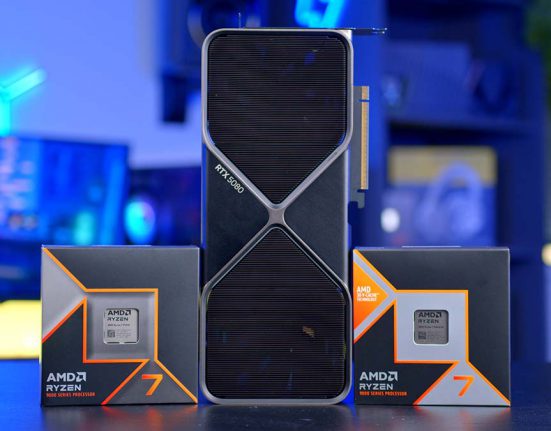ASUS ProArt motherboards are geared explicitly towards creators with workstation setups. The ProArt X870E-CREATOR WiFi is a top-end board with the latest Zen5 features designed to deliver excellent performance, connectivity, and expansion for demanding workloads. With dual Gen5 graphics card slots, plenty of high-speed storage, and a bountiful set of rear IO providing blazing-fast speeds, the X870E-CREATOR WiFi is well-equipped. To see how this ProArt board compares to other top-end motherboards on the market, we’ve analysed and tested it in a series of benchmarks.
Finding a motherboard with the right features for a workstation setup isn’t the most straightforward task. While most enthusiast gaming boards will likely accommodate most prerequisites, they often can’t cover everything. Features like dual Gen5 slots, top-end ethernet, or high-speed IO are often reserved for workstation-focused boards. This is why the ProArt X870E-CREATOR offers a unique value proposition compared to other boards. But we’re curious to see if the ProArt board is a competitive option when it comes to pricing or whether it is worth just buying a gaming board instead.
This review looks at the ASUS ProArt X870E-CREATOR WiFi in great depth. We’ve delved into the specs, design, box accessories, connectivity, and features to see how this motherboard compares to other market alternatives.
Buy the ASUS ProArt X870E-CREATOR WiFi on:
Specification
Like its predecessor, the X870E-CREATOR WiFi is an ATX motherboard with ample connectivity and expansion options. Regarding overclocking capabilities, the ProArt CREATOR board supports a max of 192GB DDR5 at 8000MT/s. Compared to the ROG STRIX X870E-E Gaming WiFi, this is 400MT/s less. This likely comes down to the fact that the ProArt board doesn’t employ the ASUS NITROPATH technology, which optimises DIMM speeds.
This board offers a 16+2+2 VRM power phase configuration for CPU overclocking. Overclocking is generally not a massive focus for ProArt CREATOR boards, hence the lower number of phases than some of the flagship X870E motherboards. However, features like the dynamic OC switcher and automated AI solutions in the BIOS will simplify overclocking.

One key expansion characteristic of the ProArt X870E-CREATOR is its two Gen5 x16 graphics card slots. This is particularly handy for those looking to maximise performance with two GPUs. Technologies like SLI (scalable link interface) and Crossfire were ditched some time ago for gaming GPUs. However, NVIDIA and AMD workstation cards are often used in multi-GPU configurations for intense workloads like CAD or AI learning, so a board like this helps those projects come to life.
There are four slots total for storage: two Gen5 and two Gen4. While it would be great to see widespread PCI-E 5.0 compatibility across the board, this amount of storage is ample for most setups, especially if we’re considering this from a speed point of view.
| Specification | ASUS ProArt X870E-CREATOR WiFi |
|---|---|
| Form Factor | ATX |
| Supported Memory | 192GB DDR5 8000MT/s |
| PCI-E x16 Slots | 2 x PCI-E 5.0 1 x PCI-E 4.0 |
| PCI-E x4 Slots | 2 x PCI-E 5.0 2 x PCI-E 4.0 |
| VRM Power Phases | 16+2+2 |
| Front IO | 1 x USB 3.2 Gen2x2 Type-C 1 x USB 3.2 Gen1 Type-A 3 x USB 2.0 |
| Rear IO | 2 x USB4 Type-C 1 x USB 3.2 Gen2x2 Type-C 7 x USB 3.2 Gen2 Type-A 1 x USB 2.0 |
| Audio | 3 x Audio Jacks |
| Networking | 10 Gigabit LAN 2.5 Gigabit LAN WiFi 7 |
IO is where this board thrives compared to most gaming motherboards. On the front, there is one USB 3.2 Gen2x2 Type-C header, one USB 3.2 Gen1 Type-A header supporting two ports, and three USB 2.0 headers supporting six ports. We’d like to see more USB4 compatibility here for those with specific cases, but the Type-C port is solid. It’s worth noting that the Type-C header also offers 30W power delivery and QuickCharge 4+.
Eleven ports on the rear IO provide connectivity for plenty of external SSDs or peripherals. The ProArt X870E-CREATOR features two USB4 ports, one USB 3.2 Gen2x2 Type-C port, seven USB 3.2 Gen2 Type-A ports, and a single USB 2.0 port. The USB 2.0 on the rear IO can use a USB stick for BIOS flashback, but it doubles as a standard USB 2 port. The IO is excellent on this board. USB4 is particularly helpful with big file transfers as the ports can reach a maximum speed of up to 40Gbps.
The rest of the IO houses dual LAN, with a 10 Gigabit port and a 2.5 Gigabit port. This is handy for setups with a home server. The 10 Gigabit port can be used to shift massive files, while 2.5 Gigabit is ideal for an internet connection. Alternatively, this board also has WiFi 7 for those looking to avoid wires. For audio, the X870E-CREATOR is relatively basic, with three 3.5mm audio jacks. This is slightly disappointing, as these ports aren’t likely enough for an advanced speaker setup.
What’s in the Box?
In this section, we’ll showcase the accessories that come with the box. Manufacturers will generally provide extra gadgets and useful items to streamline the building process, which we’ve covered below.
As we’ve covered in the ROG Strix X870E-E Gaming WiFi review, most of the Zen5 boards use WiFi 7, which improves stability and speeds compared to WiFi 6E. Although it requires a supported router, the new antennas are better.

Additionally, the connection to the rear IO has changed. WiFi antennas typically use a hex-based nut that screws to the IO. However, WiFi 7 uses a quick connect port that snaps into place.

The board also comes with four SATA cables. These are particularly useful for those with SATA-based storage devices, providing extra expansion options.

ASUS has included a range of usability features with these new X870E boards to make building a PC straightforward. Their M.2 Q-Latch and M.2 Q-Slide provide a way to install SSDs without any tools. ASUS has included an extra latch and Q-Slide with the ProArt X870E-CREATOR, which adds solid value. There’s also an M.2 22110 thermal pad for those with larger M.2 SSDs.

The last accessory in the box is a ProArt-themed 12cm ruler. Like the cards and stickers with other ASUS motherboards, these don’t add anything to the building process. However, this is a unique gift that fits the board’s style.

ASUS ProArt X870E-CREATOR WiFi Design
The ProArt X870E-CREATOR motherboard is one of the more plain-looking PCBs on the market. This board features a black and gold finish across the heatsinks, along with one of the brand slogans towards the middle of the board. ProArt options are generally more toned down in terms of the aesthetic, which makes it easier for them to blend in with an office setup. This also means there’s no RGB lighting on the board, either.

I don’t mind the design of the ProArt X870E-CREATOR WiFi. Nothing particularly stands out regarding the look, but I can appreciate ASUS’s minimalist aesthetic. Compared to the X670E-CREATOR WiFi, it looks pretty similar, except for removing a heatsink that would typically cover the audio chips.

The ProArt X870E-CREATOR would benefit from having more heatsinks on the board. While I can appreciate that having fewer heatsinks is likely a cost-saving measure, a board that is supposed to ‘manifest a professional, elegant and precise vision’ could look better. An extensive heatsink design would cover up the more rugged look of the PCB, providing a more well-rounded style.

Additionally, I’m not a massive fan of the odd plastic over on top of the rear IO. It has some ProArt branding, but it looks a bit cheap. Again, I’d prefer this to be metal, as it would look more refined. This isn’t a deal-breaker, but it’s another design quality that could be improved.
Overall, I think the ProArt X870E-CREATOR’s design is fine. It isn’t the most sophisticated board we’ve reviewed. The gold across some of the heatsinks makes the board look somewhat refined, but the PCB could use more heatsinks to cover up the barebones aesthetic of the board’s components.
Connectivity Options
Graphics Card Slots
GPU expansion across all of the ProArt motherboards is generally solid. These boards are designed to offer more connectivity than gaming-focused options, so it’s no surprise to see dual Gen5 x16 GPU slots. These are geared towards those with multi-GPU setups that can use shared resources, such as workstation cards. Alternatively, those looking to maximise connectivity or storage space could plug in a Thunderbolt 4 or M.2 expansion card.

M.2 Slots
ASUS have divided the motherboard into two distinct areas for storage expansion. The SSD at the top of the board underneath the CPU socket is a full-size Gen5 slot and sits underneath a large heatsink. This heatsink can be easily removed with the ASUS Q-Release button, and the SSD can be secured with the Q-Latch, which doesn’t require any tools.

The second set of heatsinks are all located around the second graphics card slot. The drive at the top right is Gen5, while the bottom two are Gen4. Again, these are covered in heatsinks that are screwed down. All of these drive slots also feature the Q-Latch mechanism.

RAM DIMMs
Regarding RAM compatibility, this ProArt board supports speeds up to 8000MT/s and a maximum of 192GB. The ProArt X870E-CREATOR doesn’t use NITROPATH, so the actual DIMM slots are likely similar to the previous generation. It’s also worth highlighting that the current spec supports 192GB, instead of 256GB

Rear IO
Rear IO is where the ProArt X870E-CREATOR WiFi stands out versus the competition. Like the ROG Strix X870E-E Gaming WiFi, this board has solid connectivity options. In terms of USBs, there are eleven ports here. The primary makeup of the rear IO is USB 3.2 Gen2 ports (10Gbps), of which there are seven Type-A ports. There are also two USB4 ports rated at 40Gbps and a USB 3.2 Gen2x2 Type-C port offering up to 20Gbps. The rear IO also houses a USB 2.0 port for those using BIOS flashback.

There are two Ethernet ports and WiFi 7 for networking. Prospective buyers can utilise 10 Gigabit LAN or 2.5 Gigabit LAN, which offer stability and excellent speeds. WiFi 7 is a good alternative for those not looking to run cables from their router. Audio is slightly lacklustre compared to other boards, which is a shame. Many of the boards we’ve looked at tend to offer optical S/PDIF or more audio jacks, so the limited audio on this board will be restrictive for those with speaker setups.
Internal Headers
CPU and Motherboard Power
The CPU and motherboard power configuration on the ProArt X870E-CREATOR WiFi is pretty standard. Because this board doesn’t massively focus on overclocking, there are only two EPS 8-pin CPU connectors. Some boards with higher VRM power phase configurations may use three headers, but it isn’t necessary for this ProArt board.

Again, this board isn’t built for enthusiast-level overclocking, so ASUS has opted for a basic 24-pin header. Strangely, the additional 6-pin has been dropped, which was a feature on the previous generation X670E version of this board. This might be due to the platform optimisations and improved efficiency with the Zen5 CPUs.

Front USB Headers
The front IO options on this board aren’t as impressive as the rear, but ample headers still provide plenty of versatility. The USB 3 and USB-C headers are located on the right-hand side of the board, just underneath the motherboard power. In the image below, the USB Type-C port is the silvery-coloured header off to the right.

The ProArt X870E-CREATOR WiFi has three USB 2.0 headers, supporting six ports. It’s great to see numerous USB 2.0 ports on a board, especially as more coolers and fans use them to gather thermal data. These headers are at the bottom of the board, just underneath the PCI-E Gen4 x16 slot.

Pump and Fan Headers
I was pretty surprised at how many fan/pump headers there are on the ProArt X870E-CREATOR board. At the top, you’ll find three 4-pin PWM headers. From left to right, these are ‘CPU_FAN’, ‘CPU_OPT’, and ‘AIO_PUMP’.

The ‘CHA_FAN’ headers are relatively dispersed on this board. The first two are on the left, next to the first Gen5 SSD slot. Number three sits underneath the Gen4 x16 slot. Four is directly next to the USB 3.0 header, and five is at the bottom right of the board next to JFP1.
RGB Headers
This motherboard has three addressable 3-pin RGB headers. The first is shown in the image above, next to the main set of PWM fan headers.

The other two are next to the USB 2.0 headers at the bottom of the motherboard. It’s good to see the inclusion of these headers, even though the ProArt is targeted more towards professionals.
SATA Data Ports
Although M.2 is generally more popular for storage, SATA SSDs and hard drives are (sometimes) cheaper. It’s good that ASUS still caters to those with older storage devices by providing SATA data ports. There are four on this board, two next to USB 3 and two next to USB 2.

Building with the ASUS ProArt X870E-CREATOR WiFi
Like other ASUS motherboards we’ve reviewed, building with this board was simple. The selection of features and valuable design qualities streamlines the PC building process.
The ProArt X870E-CREATOR WiFi is an ATX option, so it easily slots into most modern cases with no issues. The chassis that we installed this board in was pre-configured out of the box for ATX boards, so it was simply a case of sliding it in and screwing it down. The integrated IO shield also made this easy, as we didn’t have to install one into the case.
The sheer number of fans and RGB headers on the ProArt X870E-CREATOR WiFi made plugging in fans and a cooler very simple. The headers are dispersed in easily accessible places on the board, so managing the wires is straightforward.
Overall, the ProArt X870E-CREATOR WiFi made building a PC pretty easy. As a general rule of thumb, most motherboards don’t make building harder unless they’re designed strangely or utilise a non-traditional form factor. However, we can appreciate the effort that ASUS has gone to with the ProArt X870E-CREATOR WiFi to make assembly and installation as quick and uncomplicated as possible with minimal tools.
Features We Like
PC DIY-Features
We hugely appreciate DIY-friendly features, as they make building a PC painless. The ProArt X870E-CREATOR WiFi alleviates the hassle of pushing down a PCI-E slot mechanism or unscrewing an M.2 SSD heatsink.

While some of these features tend to be reserved for top-end motherboards like the ProArt range, it’s unique qualities like this that make these boards well worth considering.

Features We Don’t Like
Lack of Audio Connectivity
We’ve briefly touched on this in the specs section, but as a board geared towards professionals and creators, it doesn’t make sense that there are only three 3.5mm jacks on this board. This rules out those with various audio interfaces or more complex speaker setups, which is disappointing.

Conclusion
ASUS ProArt X870E-CREATOR WiFi
Product Name: ProArt X870E-CREATOR WiFi
Brand: ASUS
-
Features
-
Design
-
Performance
-
Value For Money
Summary
The ASUS ProArt X870E-CREATOR WiFi motherboard is a solid pickup for a workstation system. Its set of features offers plenty of connectivity and expansion options for creators, which includes high-speed dual 10 Gigabit and 2.5 Gigabit networking, a vast selection of blazing-fast ports on the rear IO, and room for dual Gen5 graphics cards alongside four M.2 storage slots. There is a clear focus on providing value for professionals and content creators, and ASUS has gone the extra mile to make building with this board a breeze thanks to all of its versatile features. I genuinely believe that this board offers more value for creators over a gaming desktop option, which makes it unique compared to market alternatives.
The only big issue I have with the board is its design. It’s bland. I understand that ASUS has taken a minimalist approach here to blend in with an office setup, but I feel that for a $500 board, the ProArt X870E-CREATOR WiFi could look better. Remove the plastic on the rear IO, bulk up the PCB with more heatsinks, and add more splashes of gold here and there to provide better contrast. This would give a more well-rounded look that matches the price point better. However, if you’re not bothered about the look of this board, it’ll be worth picking up for a workstation system.
Pros
✅ Solid port selection
✅ Excellent networking
✅ Highly versatile
Cons
❌ Lacklustre design
❌ Pricey
❌ Lacking audio connectivity



![FI_[DP056] Antec flux M + 9060XT](https://geekawhat.com/wp-content/uploads/2025/12/FI_DP056-Antec-flux-M-9060XT-551x431.jpg)




